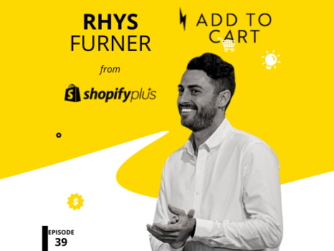In this episode of Add To Cart, we are joined by Basil Karam, CEO and co-founder of online homewares store, Life Interiors. As with many in the homewares category, Life Interiors had a massive 2020 and are on track for an even bigger 2021 off the back of a replatforming over to Shopify Plus, a smart omnichannel set up and investment in technologies including augmented reality and artificial intelligence. IN tis chat, we hear the Life Interiors story, including how they started on eBay and as a replica furniture company – a far cry from today where they are now one of Australia’s leading furniture designers and retailers. The next frontier? A BHAG of doing $100m online! Basil is at heart a technologist and it is fascinating to get his view on how to build an online business that can scale but still be unique.
“Don’t be scared to have a vision, execute on that vision and make difficult decisions“
Michael Beveridge
Questions answered in this episode include…
- What have been the most significant challenges of re-platforming for Life Interiors?
- What’s the relationship between online and offline for Life Interiors and how do you measure attribution for each?
- How and why did Life Interiors migrate from selling replica furniture to creating their own designs?
Don’t be afraid to have a vision and execute on that vision
My background is technology so it wasn’t really furniture. For us, if you dial back ten years, the eCommerce space or I guess the confidence that people have to purchase furniture online, was really replica furniture. Brands like Matt Blatt, Milan Direct, all got their start really to sell replica furniture online. There are other brands as well, but they were some of the main ones. Customers were comfortable, they knew the product, they knew the design, there was obviously a sense of, “I’m getting a bargain” as opposed to buying the original.
But for us the question … I mean, after a couple of years, we decided at the end of the day, two things. One, the ethics around it wasn’t right. Two, to acquire great talent in the space meant that we had to have a business that was I guess in the eyes of our employees, something that we would be proud of, as opposed to simply focusing on the revenue. We really pivoted away when the business was growing, which was a challenge because we didn’t have the excess capital. It was like literally driving down the freeway and changing tires as we were going.
So, we’d started that process and what most people don’t know is I think maybe about six months in the process where we just decided, “You know what? We’re changing tack completely in terms of where we’re going.” It’s going to be a long journey, a difficult one. It could take a couple of years, and as we started it, our key supplier which at the time was supplying Matt Blatt, and it was well over 50% revenue of the business, decided that they didn’t want to supply us product anymore.
That was like, “You’ve got to be joking!” Obviously that sped up the speed of our migration but even then we were looking at some of the replica stuff, as well, because I mean we just couldn’t move that fast. Lucky we’d already started that journey. We had the vision of where we wanted to get to, and what you’re seeing at the moment with Life Interiors, really that was six or seven years ago, because we are now where we wanted to be.
My only advice is don’t be scared to have a vision, execute on that vision, and make difficult decisions because if you don’t make the difficult decisions and you know when it’s right and wrong in the pit of your stomach, you don’t want to be forced to make that decision because it just means you’re on the back foot. For us, we’re on the front foot and we’re starting to reap the rewards of that by having a brand and product that are really unique in the market, really resonating with our customers.
The relationship between online and offline
It’s just understanding your customer and while we know eCommerce is obviously growing at a rapid rate, the majority of our customers still interact in the physical world and do want to touch and feel. It’s not about the philosophy of it’s one versus the other, it’s how do you cost effectively interact with your customers? And what is the best way to do that from their eyes?
For us, we landed on a destination model. You’re not going to find us in Westfields or any of these big retail strips. You’re going to have to drive to us historically in a warehouse, a low cost environment and where we are at the moment in Lilyfield, and Abbotsford down in Melbourne, you’re driving to us, within generally within that five, six, seven kilometre radius of the CBD. It’s pretty easy to get to and pretty central, but rents are cheaper. You’re coming to us with the intention to purchase after doing some research.
We have a very high conversion rate when people walk into store, and that means we can resource accordingly, because we’re not really investing in people who are just browsing. They’re really coming in to execute. It’s allowed us to tailor that to us and really also obviously brands like Google and the like who are obviously trying to converge channels together, as well, really start to leverage things like [inaudible 00:20:30].
Where consumers can now, within 10 kilometres of our stores, search for bar stools or dining chairs and see if that inventory’s actually in-store. We were one of the first in Australia to actually roll that out, and the funny story is Google actually sent out third party consultants with tablets and they physically checked every item in our showroom. It was about a week before the 30th of June, so it was like the running joke was we should have got them to do our stocktake, because literally they actually came in to do that stuff. That was maybe three or four years ago.
But once again, it comes into the power of using both channels effectively to drive people into store and ideally, have a really good user experience, because obviously no one wants to come into store thinking an item’s available to touch and feel, and getting there and realizing it’s not.
Share of Home
For us as a business, obviously focusing on that user experience and really building out and understanding what that user journey is, as well. And really starting to differentiate our offering from other competitors around the user journey, and a key metric for us in the furniture space is what we refer to as ‘share of home’. In an ideal world, as opposed to say LTV, which obviously tie directly into it, is how many categories can someone purchase from us? If they buy a sofa, can they buy a cushion? If they buy a sofa, can they buy a coffee table? If they buy a bed, can they buy bedside tables? And slowly put systems in place where we can inspire customers to make those incremental purchases over the course of refreshing the house.



